Kevin Schwantz has a four-year-old black lab named Tank. At the press introduction for the 2015 Suzuki GSX-S750, held near his home in Austin, Texas, we of the fourth estate were invited into his home for some fantastic Texas barbecue. Tank walked calmly among the 30 or so guests, wagging his tail and greeting the strangers like such a thing happened every day. He eyed the trays of succulent meats, caught your glance and looked back toward the dinner with the expression that said "oh, please!" But he never begged, never sniffed out food that wasn't offered.
The perfect pet for a generous host.
A metaphor for Suzuki’s latest naked bike? Perhaps. Probably, even. We’ll know more in a week or so when we get a test unit on dry ground. As it happened, cold, wet weather prevented us from putting many miles on the bike—the total was about 120 miles—and certainly kept thoughts of aggressive riding locked safely away. Despite the suboptimal conditions and lack of any kind of rider aids on the GSX-S, each test unit returned to the trailer unscathed except for a fine layer of road muck. That has to say something.
What we can say is this: Suzuki has elected to feather into the accelerator this year after coasting along during the fallout from the economic crisis of 2008. Sportbikes were hit hard, Suzuki harder. Now there are hints of exciting new product in the pipeline including, to no one's surprise, a totally new GSX-R1000 that we're speculating will break cover during this, the 30th anniversary of the model line, as a 2016 model.
In the meantime, Suzuki will bring us a couple of new naked and semi-nude street models to fill out the lineup. This summer, around the time of the MotoAmerica/World Superbike round at Mazda Raceway Laguna Seca in July, we’ll have our first taste of the GSX-S1000 and GSX-S1000F, but for now it’s the 750.
A new model for the US, the GSX-S is not a new machine for Suzuki. Sold as the GSR750 in Europe since 2011, the 750 comes to the states as a price-point machine, sitting at $7,999 in matte black ($8,149 with the white/blue scheme that also features a deeper gold anodizing to the fork legs but no performance differences) to undercut Yamaha’s successful FZ-09 by a little and Honda’s smaller, fully faired CBR650F by $500. ABS is available on the European GSR, but the US won’t get that model; of these three, only the Honda can be had with ABS (for $8,999).
To hit that price point, Suzuki started with a tried-and-true engine, which is marketing speak for old. In this case, it’s the GSX-R750’s of 2005. (It’s actually an important break point because for 2006 Suzuki shifted emphasis to development of the GSX-R600, which had shared virtually everything with the 750 besides displacement. In doing so, Suzuki made the 750 a long-stroke engine so that the shared cases could be more compact.) For the GSX-S, there is a revised cylinder head with smaller ports feeding smaller valves. Milder cam timing, too. And while the compression ratio remains at 12.3:1, the engine has a lower rev limit: 11,250 rpm versus the GSX-R750’s 14,000.
Suzuki in its technical presentation made the point that this is not a "detuned" GSX-R engine but rather one with Gixxer bones carefully recalibrated for improved low-end and midrange power. But the results are more or less the same. Back in the day, Suzuki claimed 147 crankshaft horsepower for the GSX-R. While we couldn't get power claims for the GSX-S, the European model is said to make 105 hp at the crank. Assuming the usual 15-percent drop from crank to rear wheel, that puts the GSX-S at around 89 hp, right between the Honda CBR650F's 78 hp and the FZ-09's 105. (UPDATE: Since this story was published, we got the GSX-S to the dyno, where it put down 95.3 hp at 10,200 rpm and 52.3 pound-feet of torque at 8,600 rpm.)
Start the bike, click it into gear, and ride the 100 feet out of the parking garage and you already know this is not a GSX-R engine any longer. Throttle response off the bottom is smooth and very progressive, but the engine has none of the eagerness, the race-bred snap of the GSX-R’s. The powertrain keeps the GSX-R’s sweet, light clutch action (via cable) and precise, short-throw shifting. But it’s very obviously been house trained.
For the first few miles of the press launch, navigating a maze of rain-slicked Austin streets, that’s just fine. Power doesn’t so much come on as build gradually through the midrange; it’s flexible and predictable, which is great. Your natural inclination is to shift around 5,000 rpm, before the vibration starts picking up in the footpegs and the flanks of the 4.6-gallon tank.
Around town, dodging pickups and ubers, the GSX-S feels great. The riding position is typical “streetfighter” with a relatively tight seat-to-peg distance and a slight reach over to the low, 7/8-inch (very obviously low cost) tubular handlebar. We’d say the Suzuki feels a little longer than an FZ-09, but the tape might say otherwise; definitely, it’s close. And comfortable. The position encourages a slight forward cant to overcome the lack of wind protection. Narrow at the front to help those with short legs, the seat worked well enough over the 100-mile ride that few of us complained.
By the time we hit the hill-country roads west of Austin, the rain had intensified so the pace behind Schwantz was extremely sedate. Initial impressions are that the GSX-S has light, neutral steering on the stock Bridgestone BT-016 radials—in regular sportbike sizes, thank you; 120/70ZR-17 up front, 180/55ZR-17 out back. We’ll know more about the handling when we get to drier ground, and while we’re hoping for the best out of the two-piston, sliding-pin Tokico brakes up front, we won’t be surprised to be underwhelmed. A clear cost-cutting move, Suzuki selected a brake set that’s long been obsolete, even for a budget-constrained, quasi-entry-level machine.
And while the KYB suspension front and rear has adjustments for spring preload only—at least it has that, which is more than can be said for the more expensive Honda CBR650F—its calibration seems very good. As in: Not all softly sprung and under-damped. True, lighter riders might actually think the suspension is a bit too firm, but for heavier/more experienced riders, the realization that the chassis displays minimal pitch and few unrefined movements is surprising. Again, we’ll wait to issue a final verdict until we can ride the GSX-S hard enough to see what the legs do under load.
We did get a chance to unleash the powerplant a little on some drying roads later in the day. After a nice midrange surge, the power levels off until about 8,000 rpm and then has a nice little rush to the 11,250-rpm redline. It’s not charging super hard to the rev limiter, but it’s a nice surprise considering how polite the bike is otherwise. Is this the kind of kinetic, front-wheel-lightening, knees-against-the-tank surge you get from the FZ-09? No, not even close. But some of that might be weight. Yamaha claims 414 pounds wet for the FZ; consider that against the Suzuki’s claimed curb weight of 470 pounds. Plus, the Suzuki does its business in a very quiet way, with none of the old GSX-R’s intake moan or mechanical urgency.
Perhaps our impressions were “dampened” by the weather, but the overwhelming feeling is that the GSX-S was built to reduce intimidation and keep a lid on costs. It seems competent for the price point and maybe just a little careful. In the end, black lab Tank might prefer taking up shotgun in Kevin’s immaculate E-Type Jaguar to riding on the back of the GSX-S, but he probably wouldn’t pee on the Suzuki’s tires.










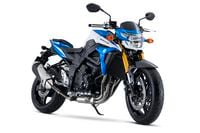
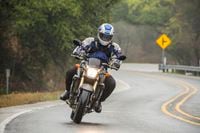
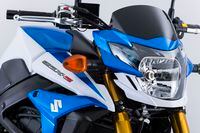

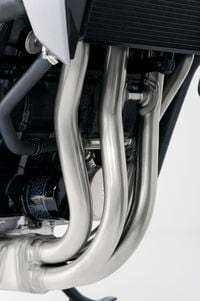






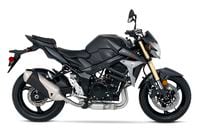






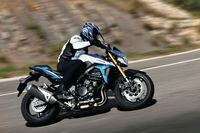

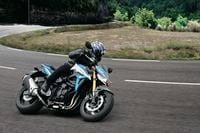
/cloudfront-us-east-1.images.arcpublishing.com/octane/IIGGWFOTOJGB7DB6DGBXCCMTDY.jpg)
/cloudfront-us-east-1.images.arcpublishing.com/octane/QSTCM6AVEZA5JJBUXNIQ3DSOF4.jpg)
/cloudfront-us-east-1.images.arcpublishing.com/octane/U4I7G625B5DMLF2DVIJDFZVV6M.jpg)
/cloudfront-us-east-1.images.arcpublishing.com/octane/B6XD6LS6IVCQPIU6HXDJSM3FHY.jpg)
/cloudfront-us-east-1.images.arcpublishing.com/octane/ICL63FEDDRDTTMINYICCEYGMDA.jpg)
/cloudfront-us-east-1.images.arcpublishing.com/octane/FCGZHQXRBZFLBAPC5SDIQLVF4I.jpg)
/cloudfront-us-east-1.images.arcpublishing.com/octane/WNOB6LDOIFFHJKPSVIWDYUGOPM.jpg)

/cloudfront-us-east-1.images.arcpublishing.com/octane/X33NU3E525ECRHXLNUJN2FTRKI.jpg)
/cloudfront-us-east-1.images.arcpublishing.com/octane/6KKT5NNL2JAVBOXMZYS5ZO76YA.jpg)
/cloudfront-us-east-1.images.arcpublishing.com/octane/J5RKG5O455GMPGQRF2OG6LRT7A.jpg)
/cloudfront-us-east-1.images.arcpublishing.com/octane/GX2CIZKQVRH2TATDM26KFG2DAE.jpg)
/cloudfront-us-east-1.images.arcpublishing.com/octane/ZWIDYSAKQZHD5BHREMQILXJCGM.jpg)
/cloudfront-us-east-1.images.arcpublishing.com/octane/CYUHJZCTSJCH3MRAQEIKXK7SCQ.jpg)
/cloudfront-us-east-1.images.arcpublishing.com/octane/LKOFINY56FCXJCANJ5M7ZDQUBY.jpg)
/cloudfront-us-east-1.images.arcpublishing.com/octane/4NBPDACMWJH63JQYJVK3QRBDZI.jpg)
/cloudfront-us-east-1.images.arcpublishing.com/octane/KKHQHRR3FJGX7H2IPU6RALMWG4.jpg)

/cloudfront-us-east-1.images.arcpublishing.com/octane/5IOFS5JAE5FOXMNA23ZRAVVYUU.jpg)
/cloudfront-us-east-1.images.arcpublishing.com/octane/CGXQ3O2VVJF7PGTYR3QICTLDLM.jpg)

/cloudfront-us-east-1.images.arcpublishing.com/octane/OQVCJOABCFC5NBEF2KIGRCV3XA.jpg)
/cloudfront-us-east-1.images.arcpublishing.com/octane/OPVQ7R4EFNCLRDPSQT4FBZCS2A.jpg)
/cloudfront-us-east-1.images.arcpublishing.com/octane/YBPFZBTAS5FJJBKOWC57QGEFDM.jpg)